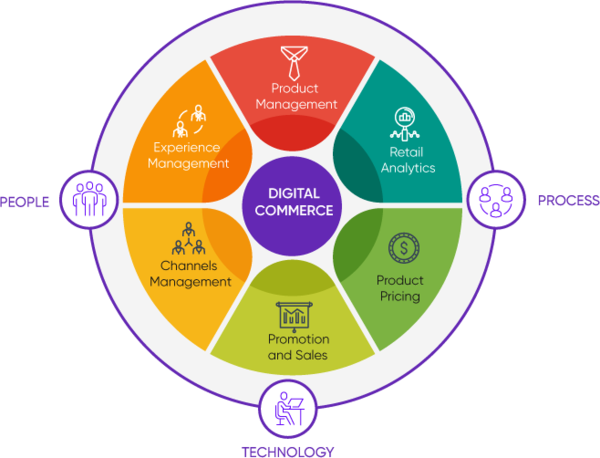How Does Open-Source Open Innovation Doors in Digital Commerce?
What’s the most crucial factor for success in digital commerce? Is it a creative idea or massive investment? Taking risks or going the traditional way? More than anything else, it is about responding to customer needs in real time. It is about continuously improving the user experience of potential buyers, no matter where they are. It is all about customers.
Digital Commerce Players’ Innovation Goals
- Improve Agility: Implementing more lightweight, agile digital commerce solutions to improve the customer experience and lower TCO
- Bridge Physical and Digital Gap: Meeting customer expectations at every touch point (omni-channel) and improving predictive outreach across physical and digital stores
- Enrich Experience: Integrating personalization (chatbots and virtual assistants), payments (click and collect), customer journey analytics (AI and Machine Learning), API-based commerce platforms, and augmented commerce (AR/VR)

1. Flexibility
In digital commerce business, requirements like rich content support (videos, ratings, reviews and social sharing), advanced management (product catalog, product detail pages, and customer authentication), subscriptions and third-party integrations/ marketplace integrations increase every passing day. Along with it, continuous enhancement of APIs & features, integrations with different data sources, and multi-language & multi-currency support also expand to launch into new markets and establish new product lines. With greater flexibility or scalability, you can minimize these integration efforts and technical complexity to outgrow your existing platform.
Open Source for Increased Flexibility
Open source inherently unleashes enormous flexibility and scalability the way your business demands. In digital commerce, it enables you to build an agile, modular, global, and multi-site architecture that evolves fast as per the future needs. It lets you pick the best-of-breed solution rather than one package.
- Freedom from vendor lock-in thus scale with confidence across channels and geography
- Modify and customize to meet industry compliance and standards
- Regular updates and patches to ensure better security, performance, and experience
Example: If we compare open source data collector tools like Fluentd with other proprietary tools, then Fluentd is more flexible to be integrated with a much more significant number of input and output sources.
2. Speed-to-Market
Speed largely drives digital commerce innovation. From connecting to new data sources, developing new features, reducing lead times for product or service development to promoting products, you need to act faster than your competitors. Reduced go-live time and more repeatable and scalable processes accelerate product innovation; hence you can onboard more buyers. And, when a solution is delivered in near real-time, it automatically improves service excellence and business efficiency.
Open Source for Faster Time-to-Market
Another central advantage of open innovation is the time-to-market factor. Good open source code can be used in many ways for faster execution. And, digital commerce players can leverage this capability in integrating newer ideas in order to open new functionalities and creating new markets.
- Open standards so that you don’t have to reinvent every time
- Open data standards allow to easily integrate with different systems and unify data from disparate sources (even cloud sources) in various formats
- Open code improves trust, transparency, and security
Example: Open source tools like TensorFlow are quickly enabling the democratization of machine learning. With machine learning, eCommerce businesses are doing amazing things like correcting product catalogue, improving product attribution, image recognition, and more.
3. Interoperability
Right products to the right audience at the right time are key to convert more buyers. Technical interoperability in digital commerce ensures that different implementations or enhancements remain compatible with users. This further gives the opportunity and freedom to create something new, to test fresh waters, and to go where no one has gone before.
Open Source for Improved Interoperability
Open Source based platforms are developed on open standards. They are easily interoperable with other standards-based systems and technologies. This makes easier for you to modify your platform to meet any specific business need. Open source platforms can even play well with other proprietary systems, apps, and products to properly manage the interaction between systems.
- Open code allows you to make necessary changes to interoperate as you wish
- Open source interoperability and open standards are the most viable option for adopting IoT, AI, Machine Learning and other automated systems
- You own the IP, thus protect your creativity and innovation
Example: Embedded Linux is now the most preferred IoT operating system. eCommerce businesses are vastly using open source and IoT capabilities to optimize inventory, efficiently manage the supply chain, and improve customer experience.
4. Cost-to-Market
Because of globalized markets and high competition, companies are striving to minimize the costs of business operation from the start of planning to market launch (= cost-to-market). License fees become a substantial cost burden, especially in the long-term. The way e-commerce business is becoming highly competitive; it is equally important to balance everything cost-wise— from innovation, operation efficiency, and customer services.
Open Source for Reduction of Cost-to-Market
Open source offers the dual advantages here. First, it lets you get rid of recurring license cost. Second, it helps you avoid functionality-bundling, so you can remove features that you do not need, want or use. It saves handsome cost percentage over commercial solutions. Plus, you can invest saved-licensed budget in other areas and resources to improve customer services and generate new revenue streams.
- No burden of long-term licensing cost
- Minimize the cost of development, IT support, and resource management
- Reduce the total cost of ownership (TCO)
Example: Pimcore provides one consolidated platform for PIM/MDM, DAM, CMS, and eCommerce, eliminating the need for managing different systems and providing lower TCO. With open APIs, Pimcore can easily integrate with any of your future systems.
Open Source Stats
Open source is awesome in many ways. Today, leading analyst firms and experts consider open source an exciting alternative for organizations. Here is why:
innovation-3
Leading expert network in Central Europe on innovation management
"97% of companies say that open innovation is important or even decisive to achieve higher levels of business performance."
TechTarget
American company which offers data-driven marketing services
"More than 90% of all software either contains open source components or is comprised completely of open source."
Gartner
A leading global research and advisory company
"Through 2020, open-source software in IT portfolios will increase at a 30% compound annual growth rate."
